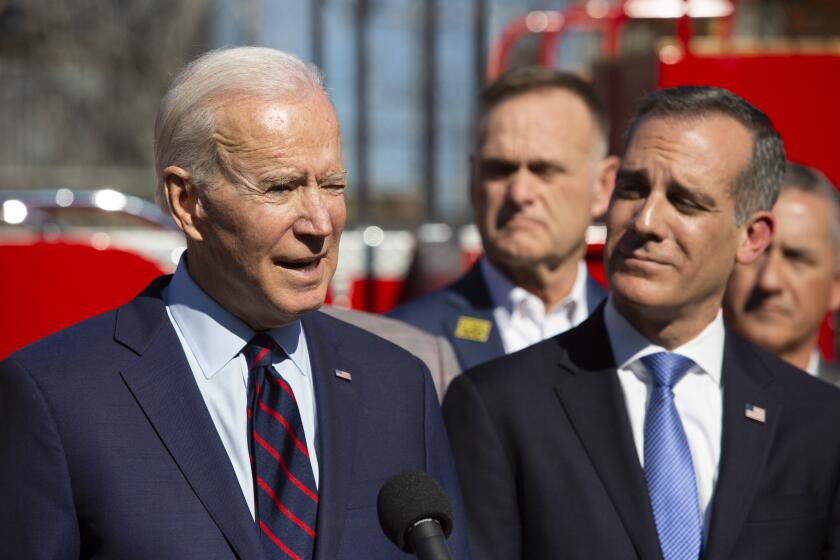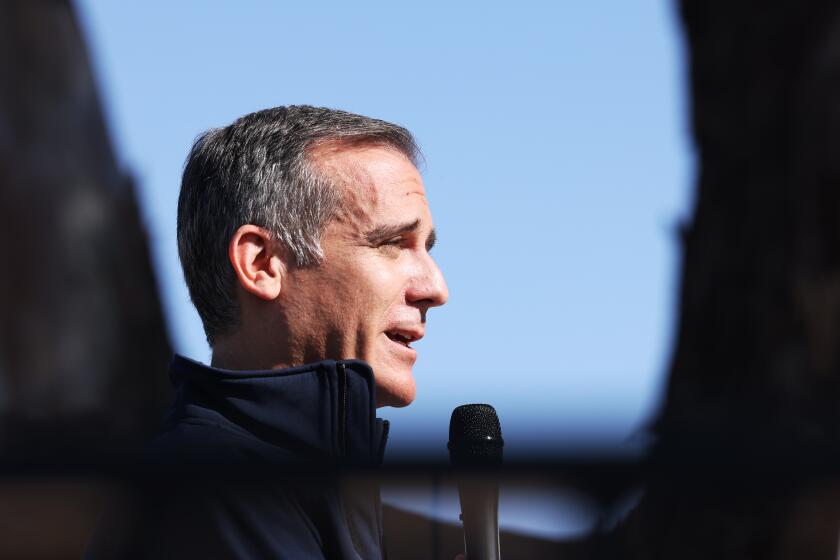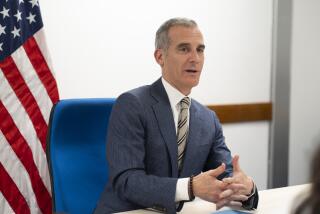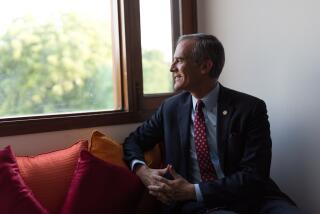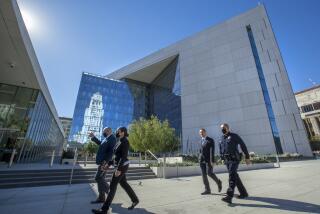Column: If Garcetti leaves early for India ambassador post, how will he be remembered?
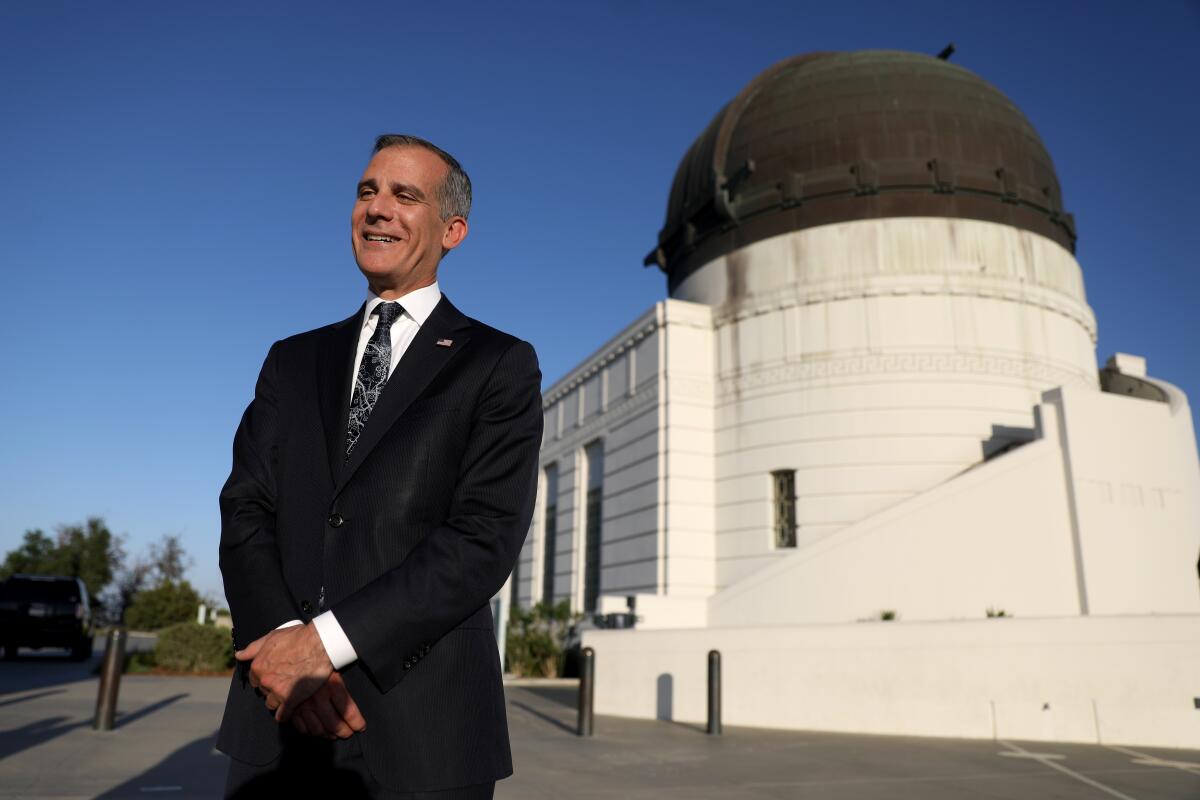
Is Los Angeles Mayor Eric Garcetti headed to India, and if so, what will be his legacy here at home after eight years as mayor and 20 years in public office?
And, by the way, who might run Los Angeles if and when he’s gone?
That’s a lot to plow through, and I’ll have to save future leadership for another column, but here we go.
If you haven’t heard, it’s been reported that President Biden could tap Garcetti to be U.S. ambassador to India. It’s not uncommon, of course, for victors to toss a bone to a loyal supporter, and Garcetti was a co-chair of Biden’s national campaign.
But India? It sounds like an odd choice at first, and one might argue that Garcetti should not be sent to a country with a massive unresolved homelessness crisis.
India is also the current global epicenter of the pandemic (Garcetti has some leadership experience in that arena) and is an important U.S. ally. And the inexhaustibly ambitious Garcetti, who has always had an interest in foreign affairs, is a Rhodes scholar who studied at the London School of Economics. So Biden could do worse, and so could Garcetti.
Now, about that legacy.
Garcetti has a fair number of critics, but let’s not forget that he was reelected in a landslide in 2017, with 81% of the vote. And he will not leave for India, or finish his current 5½-year term (an election calendar change made for a longer term), without some major achievements.
Garcetti is in the running for a post in the Biden administration, just as L.A. emerges from the pandemic, confronts a homelessness crisis and faces huge issues around race.
For me, earthquake preparedness is at the top of that list. Without any particular public demand, and despite resistance from commercial building owners, Garcetti partnered with seismologist Lucy Jones and led the way in upgrading the city’s retrofitting standards. In the next major quake, this could end up saving billions of dollars and countless lives.
“Most elected officials don’t like to do things for which the benefits will be seen 20 years or more down the road, but the costs are seen now,” said Raphael Sonenshein, who runs Cal State L.A.’s Pat Brown Institute for Public Affairs and gives Garcetti high marks for a number of achievements.
When the pandemic walloped Los Angeles, overwhelming hospitals, Garcetti helped turn Dodger Stadium and other locations into testing sites and then vaccination centers, and his daily televised briefings offered reassurance while reminding everyone to play it safe for everyone’s benefit.
We have to note the disproportionate effect on low-income minorities, the impact on the economy and the occasional missteps, but in the midst of a crisis, Garcetti was always on the front lines.
The mayor also led the charge on 2016’s Measure M, the half-cent sales tax increase that will pay for billions in transportation improvements. And he was out front on Measure H and Proposition HHH in 2016 and 2017, persuading voters to pony up more money for homeless services and housing.
“My sense is that he’s done as well as can be expected under the circumstances,” said Antonia Hernandez, who runs the California Community Foundation.
Those circumstances, she said, include the once-in-a-century pandemic and a homelessness catastrophe that is a national phenomenon with multiple causes, many of which no mayor created and no mayor can fix on his own.
Especially in a city like Los Angeles, Hernandez said, where the mayor’s powers are limited and shared with the City Council, and where social services, public health and mental health all come under county authority.
A far less generous view is offered by Jack Humphreville, a frequent City Hall critic who argued that even where Garcetti has greater authority — with basic city services and budget management — the record is nothing to celebrate.
“The thing with Eric is, though he’s a very articulate and friendly guy and he’s photogenic with a great facade, there’s a lot of B.S. in there,” said Humphreville, who holds Garcetti largely to blame for employee compensation packages that have come at the cost of budget deficits, diminished basic services, ruptured sidewalks and what he called “lunar craters” on the city’s thousands of miles of roads.
City Hall’s ingrained pay-to-play culture and recent corruption scandals haven’t directly entangled Garcetti, although a top former aide of his is being grilled over sexual harassment allegations. I don’t see any of that as a big part of Garcetti’s legacy.
Homelessness is another matter, and being out front, as Garcetti often has been, is not the same thing as leadership.
“I think he is one of the smartest elected officials I’ve ever met, and I have met a lot. The problem is that I don’t see him as an effective leader,” said Richard Close, attorney, civic activist and president of the Sherman Oaks Homeowners Assn.
Knowing policy inside out, and “being a good talker,” has not resulted in nearly enough progress on affordable housing or the homelessness crisis in the view of Close, who told me he has known Garcetti since the mayor’s father, Gil, first ran for district attorney.
Close has hit upon something there. Garcetti can eloquently rattle off the successes on homelessness in terms of housing and services provided on his watch, and those achievements are not insignificant. Nor are the noble efforts of thousands of hard-working public servants.
But we all know by now that the housing financed by new tax dollars costs too much and is taking far too long to build. And we can all see with our own eyes the growing chaos and disorder on the streets, with daily death tolls and encampment blazes, with increasing amounts of suffering born of poverty, addiction and mental illness, all of it affecting both the homeless and the housed.
And, by the way, those who oppose more affordable higher density housing in their own neighborhoods are part of the problem.
But people are tired of hearing about jurisdictional limitations or the macro causes of homelessness, or that elected officials can’t agree on, let alone execute, a more effective response, along with a better return on their tax dollars.
The recent controversial clearing of the Echo Park Lake encampment was a window on the culture wars now in play between homeless advocates and the housed, and between council members with widely different approaches to the mounting challenge.
Should there be more substance abuse and mental health services? Should there be a bigger crackdown on criminal activity? More shelters or more transitional and permanent housing?
At a time when more direction is needed, along with clearly stated goals and a plan to achieve them, Garcetti was virtually invisible as Echo Park played out. That left matters in the hands of Councilman Mitch O’Farrell, even as exasperated residents of Hollywood, Venice, the Valley, Westchester and Mar Vista begged for help with their own problems.
Diana Sieker, a high school teacher who lives in Mar Vista with homeless people literally on her doorstep, understands this is complicated, messy stuff no one person can fix.
She has been both compassionate and patient while reaching out repeatedly to Councilman Mike Bonin, as well as to the mayor’s office. But she’s exhausted and disappointed, so much so that she and her husband have sold their home and will be moving to Hawthorne in a matter of weeks.
Nearly $4 million has flowed into the Mayor’s Fund for Los Angeles from donors who use accounts that allow them to shield their identities.
“For about three years now I’ve watched some of the most horrific, heartbreaking things you can fathom,” Sieker said, including people tortured by full-blown psychotic breaks and the ravages of drugs.
“We have looked out our window to see a corpse with a needle sticking out of an arm, and we’ve had to revive the person and call paramedics,” she said. “I think we deserve more from leadership on all levels, more organization, more focus and more progress. ... This has been brewing for a very long time, and I think there were steps we could have taken long ago to put us on a different path than where we are today.
“Everyone is suffering — the people who are homeless and the people who are housed, and I don’t even have the words to describe how heartbreaking it is.”
That can’t all be put on Garcetti, not by any means.
But whether he leaves or stays, homelessness is the central and most visible challenge at the moment in Los Angeles, and it will be for many years to come.
Garcetti has served the city for 20 years, more than half of them as mayor or City Council president, and much of his legacy will be tied to this one issue.
With both achievements and disappointments to date, the work is unfinished, the record mixed.
More to Read
Sign up for Essential California
The most important California stories and recommendations in your inbox every morning.
You may occasionally receive promotional content from the Los Angeles Times.

